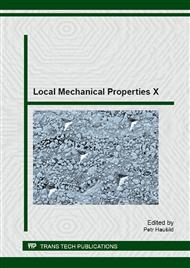p.179
p.183
p.187
p.191
p.197
p.201
p.205
p.209
p.213
Influence of the Microstructure on Macro/Micro versus Nanohardness of SiC Ceramics
Abstract:
The influence of microstructural variations on the macro/microhardness, nanohardness and Young`s modulus of liquid phase sintered silicon carbide (LPS SiC) has been observed. In order to modify the microstructures some samples were further heat treated at 1850°C for 5 hours to promote grain growth. The depth-sensing indentation tests of SiC materials were performed at several peak loads in the range 10-400 mN. For a better assessment, the indentation values of hardness and Young`s modulus modulus of SiC matrix were also compared to the hardness and Elastic modulus of individual SiC grains. The comparison of macro/micro and nanohardness showed that nanohardness was significantly higher, generally by 6-7 GPa. The nanohardness of individual plate-like SiC grains was around 2 GPa higher than nanohardness of SiC matrix.
Info:
Periodical:
Pages:
197-200
Citation:
Online since:
March 2014
Authors:
Price:
Сopyright:
© 2014 Trans Tech Publications Ltd. All Rights Reserved
Share:
Citation:


